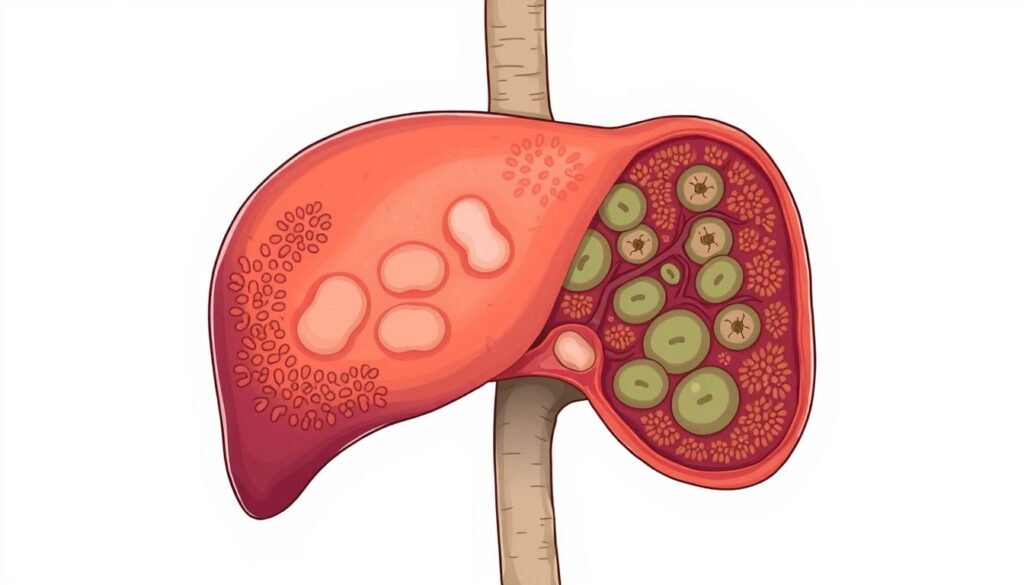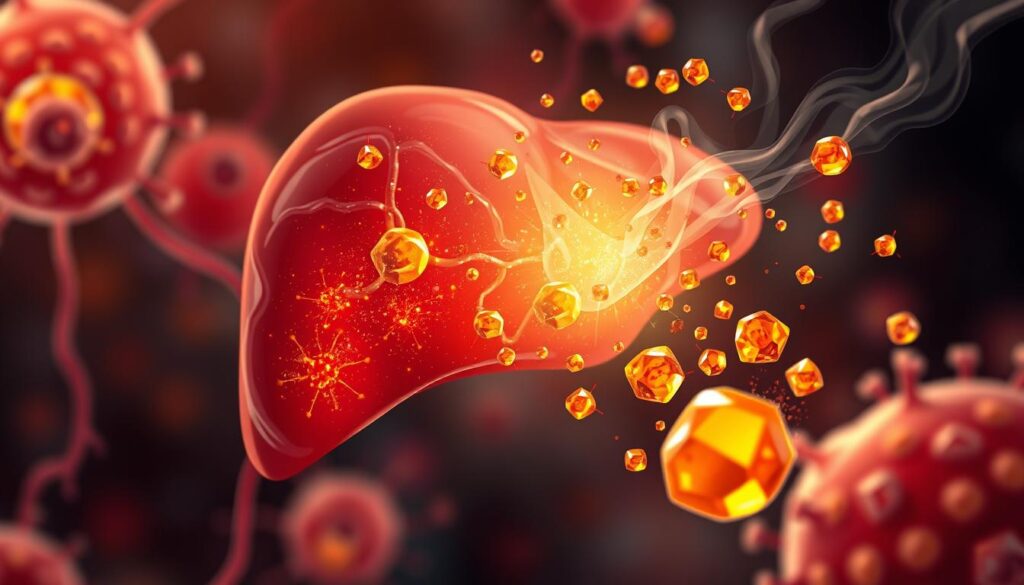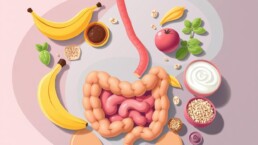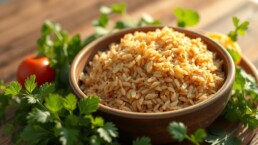In today’s fast world, high-fat diets are common. They harm our liver health. Studies show that such diets can cause fat to build up in the liver. This is called nonalcoholic fatty liver disease (NAFLD).
Table of Contents
ToggleNAFLD affects up to 30% of people in the U.S. If not treated, it can lead to serious liver diseases. These include inflammation, scarring, and even liver cancer.
Fatty liver disease, including NASH, is a big problem in the U.S. and Europe. It causes too much fat to build up in the liver. This is bad for our health. It’s important to understand how high-fat diets affect our liver.
In this article, we’ll look at how high-fat diets affect our liver. We’ll see how different fats impact our liver and health. Knowing this helps us make better choices for a healthier life.
Understanding Nonalcoholic Fatty Liver Disease (NAFLD)
NAFLD is a big problem worldwide, affecting about 25% of people. It happens when fat builds up in the liver. This is often linked to being overweight, metabolic syndrome, and insulin resistance.
As more people become obese, especially in the Middle East and West, NAFLD is getting more common.
Prevalence and Risk Factors
NAFLD is the most common liver disease globally, affecting 25% of people. It’s even more common in those with obesity and type 2 diabetes, affecting 43-92% of them. Risk factors include genetics, being overweight, insulin resistance, and high cholesterol and triglycerides.
Stages of NAFLD Development
NAFLD goes through stages, starting with simple fatty liver (steatosis). It can then turn into nonalcoholic steatohepatitis (NASH), leading to inflammation and fibrosis. This can cause cirrhosis or liver cancer.
About one-third of NAFLD cases turn into NASH. NASH is linked to higher death rates.
Clinical Significance in Modern Healthcare
In today’s healthcare, NAFLD is a big worry. It’s one of the main causes of liver disease in the U.S. and Europe. If not treated, it can cause serious problems like liver cirrhosis and cancer.
Early treatment is key. NASH patients are also at risk for heart disease and dying from any cause.
Impact of High Fat Diets on Liver Health
Research shows that high-fat, high-sugar diets harm liver health. They lead to fatty liver disease, or hepatic steatosis. Studies with nanosensors found that a Western diet causes harmful fat buildup in the liver. This buildup may not go away even with a healthier diet.
This fat buildup can start inflammation, scarring, and raise liver cancer risk. The type of fat matters, with some fats being worse for the liver than others. Saturated fats, for example, lower body insulin sensitivity and raise liver triglycerides. This worsens nonalcoholic fatty liver disease (NAFLD).
It’s key to understand how high-fat diets affect liver health. This knowledge helps in finding ways to prevent and treat NAFLD and other liver issues. By tackling the diet-related causes of liver damage, we can help people make better choices. This promotes better liver health.

The Role of Different Dietary Fats in Liver Function
Dietary fats greatly affect liver health. Linoleic acid (LA), an omega-6 polyunsaturated fatty acid, is common in Western diets. It can cause lipid peroxidation and liver damage.
Saturated fatty acids (SFA) and trans fatty acids (TFA) affect liver health differently. High TFA and cholesterol diets can cause liver fibrosis. Vitamin E helps balance the negative effects of polyunsaturated fatty acids (PUFA).
Saturated Fatty Acids (SFA)
SFA are linked to high cholesterol and heart disease. But, their direct effect on the liver is less clear. Some studies suggest replacing SFA with unsaturated fats may lower death rates.
Trans Fatty Acids (TFA)
Unlike SFA, TFA harm the liver more. Diets rich in TFA and cholesterol lead to liver fibrosis. This is a step towards severe liver disease.
Polyunsaturated Fatty Acids (PUFA)
PUFA, like omega-6 fatty acids, are vital but complex for liver health. The right balance of PUFA and antioxidants, like vitamin E, is key. It helps prevent inflammation and lipid peroxidation from high PUFA intake.
In summary, the type and balance of dietary fats are key to liver health. Eating healthy fats in moderation supports liver health. It helps prevent diseases like nonalcoholic fatty liver disease (NAFLD).
Mechanisms of Fat-Induced Liver Damage
High-fat diets harm the liver in many ways. Oxidative stress is a big problem. It happens when the body can’t fight off harmful free radicals well. This leads to cell damage and inflammation.
Inflammation is another major issue. Foods high in fat, especially trans fats and cholesterol, start inflammation in the liver. This makes liver cells get hurt more.
High-fat diets also cause lipid peroxidation. This is when free radicals damage liver cell lipids. This damage hurts cell function and makes toxic lipids build up, harming the liver more.
Too much fat can also mess up liver cells’ inner workings. It causes stress in the endoplasmic reticulum and damages mitochondria. This messes up how cells work and can make fatty liver disease worse.
It’s important to understand these complex ways fat harms the liver. By tackling oxidative stress, inflammation, and lipid problems, doctors can help the liver more. This improves health and outcomes for patients.

High Fat Diet and Hepatic Lipid Accumulation
A high-fat diet (HFD) can harm liver health by causing lipid droplets to build up in liver cells. This buildup is a main sign of nonalcoholic fatty liver disease (NAFLD).
Process of Fat Storage in Liver Cells
When we eat a lot of fat, our liver takes in the extra fatty acids. It stores them as hepatic triglycerides in lipid droplets in liver cells. The size and makeup of these droplets can greatly affect the liver’s health and how well it works.
Metabolic Changes During Fat Accumulation
As the liver gets fatter, it changes how it works. Genes that help with fatty acid metabolism, like Fgf21 and Cd36, change too. This can make it harder for the liver to handle fats, leading to steatosis and more serious liver damage over time.
The buildup of lipid droplets in the liver and the changes in metabolism are big concerns for liver health. Spotting these problems early and acting fast is key to stopping fatty liver disease from getting worse.
Inflammation and Oxidative Stress in Fatty Liver Disease
Inflammation and oxidative stress are key in fatty liver disease. High-fat diets, especially those with certain fats, can start inflammation. This makes the liver release harmful substances.
Kupffer cells, the liver’s macrophages, get active and add to the inflammation. This damage can lead to liver cell harm, fibrosis, and worse liver diseases like NASH.
Obesity has doubled worldwide from 1980 to 2008. Being overweight or obese raises the risk of metabolic syndrome. This includes high cholesterol, diabetes, and high blood fat.
Dietary fat intake has gone up a lot since 1991. Studies show a link between body fat and high-fat diets, especially with saturated fats. This can cause more body fat to produce harmful substances and inflammation.
- High-fat diets increase chylomicrons in the intestine. These enter the blood and cause free fatty acids to go to the liver, leading to bad blood fats.
- Mitochondria in the body break down unsaturated fats, causing lipid peroxidation. This adds to oxidative stress.
- ROS from high-fat diets can start pro-inflammatory signals. This activates NF-κB, leading to more inflammation and harmful molecules.

In summary, inflammation and oxidative stress from high-fat diets are major factors in fatty liver disease. They can lead to more serious liver problems. Knowing this helps us find better ways to prevent and treat the disease.
The Role of Cholesterol in Liver Health
Cholesterol is key to liver health. Too much can harm the liver a lot. High cholesterol diets can make cholesterol crystals in liver cells. This starts the NLRP3 inflammasome and causes inflammation.
This buildup affects different liver cells. It includes hepatocytes, Kupffer cells, and hepatic stellate cells. This leads to many bad effects.
Effects on Liver Cells
In hepatocytes, too much cholesterol can cause stress and death. In Kupffer cells, it leads to more inflammation and scarring. This scarring is called liver fibrosis.
In hepatic stellate cells, cholesterol makes them work too much. This makes scarring worse.
Impact on Liver Function
Cholesterol’s harm to liver cells can make the liver not work well. Too much cholesterol, especially from high-fat diets, can worsen fatty liver disease. This can lead to liver scarring, cirrhosis, and even cancer.
Understanding cholesterol’s role in liver health is crucial. We can then find ways to stop and treat liver damage. This helps keep the liver working well.
Prevention Strategies and Dietary Modifications
Preventing and managing fatty liver disease needs a full plan. This plan includes changing what we eat and how we live. Eating like people in the Mediterranean is key. They eat lots of omega-3s, antioxidants, fruits, veggies, and whole grains.
This diet helps lower liver fat and boosts liver health. It’s a big step in the right direction.
It’s also important to cut down on bad fats and cholesterol. Adding more antioxidants, like vitamin E, fights liver stress. This stress is a big part of fatty liver disease.
Staying at a healthy weight, exercising often, and not drinking too much alcohol are also key. These steps help lower the risk of getting fatty liver disease. They also slow it down if you already have it.
Getting a diet plan from a registered dietitian can really help. They can guide you to better eating and lifestyle choices. With these steps, we can all help our livers stay healthy and fight off this growing problem.

Current Research and Treatment Approaches
Scientists are working hard to find better treatments for fatty liver disease. They are looking at new ways to fix the problem. FGF21 analogues, for example, might help reduce liver fat and improve health.
PPAR agonists and GLP-1 receptor agonists are also being studied. They could help make the liver work better and slow down fatty liver disease.
Doctors now think treating fatty liver disease needs a mix of treatments. They are testing combining medicines with healthy lifestyle changes. Early results show this mix might work better than just one thing.
Emerging Therapies
- FGF21 analogues: These new drugs might help lower liver fat and improve health in studies.
- PPAR agonists: These medicines target special receptors in the liver and seem to help its health.
- GLP-1 receptor agonists: Used for diabetes, these drugs also show promise in treating fatty liver disease.
Clinical Studies and Outcomes
A study with 24 patients showed a big improvement. A diet plan and exercise made them healthier. They lost weight, got fitter, and their insulin worked better.
This study shows mixing medicines with lifestyle changes can help. As research goes on, we’ll have even better ways to treat fatty liver disease.
Knowing the early signs of liver problems is key to treating them early.
Long-term Health Implications
Fatty liver disease can harm more than just the liver. It can cause serious problems like cirrhosis and liver failure. It also raises the risk of heart disease and diabetes.
People with fatty liver disease face higher death rates. This is mainly because of heart problems. It shows why treating fatty liver early is so important.
Cirrhosis and Liver Failure
Ignoring fatty liver disease can lead to cirrhosis. This is when the liver gets scarred and can’t heal. Cirrhosis can cause liver failure, a serious condition that needs quick medical help.
Hepatocellular Carcinoma
NAFLD increases the risk of liver cancer. This is why regular check-ups are key for those with fatty liver disease.
Cardiovascular Disease
Fatty liver disease is linked to heart problems. It raises the risk of heart attacks and strokes. This highlights the need to care for both liver and heart health.
It’s vital to tackle the long-term effects of fatty liver disease. Knowing the risks and managing the condition can prevent serious problems. This improves overall health in the long run.
Lifestyle Interventions for Liver Health
Keeping your liver healthy is key for feeling good. Lifestyle changes help a lot. Things like moving more, eating right, and drinking less alcohol are important.
Exercise is great for your liver, even if you don’t lose weight. Mix up your workouts with cardio and strength training. Losing just 5-10% of your weight can make a big difference.
Drinking less is also very important for liver health. Alcohol can hurt your liver more. If you drink a lot, cutting back or stopping is best.
What you eat matters a lot too. Eating like you do in the Mediterranean is good. This means lots of fish, fruits, and veggies. Avoid too much bad fat and choose good fats instead.
Eating foods full of antioxidants helps your liver too. Think coffee, green tea, and berries. Some supplements like goji berries and milk thistle might help your liver too.
By making lifestyle changes, you can help your liver stay healthy. Always talk to a doctor before starting any big changes. They can help you make a plan that’s right for you.
Conclusion
High-fat diets affect liver health in many ways. It’s important to understand how fats damage the liver and how fatty liver disease progresses. A mix of diet changes, lifestyle tweaks, and new treatments is key to managing fatty liver.
Research is finding new links between diet and liver health. Soon, treatments might be more tailored to each person’s needs. This could lead to better ways to fight fatty liver disease.
High-fat diets have a big impact on liver health, but there’s hope. A balanced diet and healthy lifestyle can help. By focusing on these, we can improve liver health for everyone.
FAQ
What is the impact of high-fat diets on liver health?
Eating too much fat and sugar can harm your liver. This damage may not go away even if you eat better later. It can cause liver disease and even cancer.
What is the prevalence and significance of nonalcoholic fatty liver disease (NAFLD)?
NAFLD is a big problem worldwide, affecting up to 30% of Americans. It’s linked to a higher risk of death. It’s now a major cause of liver disease in the US and Europe.
How do different dietary fats impact liver function?
The kind of fat you eat matters a lot for your liver. Western diets have a lot of omega-6 fats, which can harm your liver. Saturated and trans fats have different effects than unsaturated fats.
What are the mechanisms of fat-induced liver damage?
High-fat diets can cause liver damage by increasing stress and inflammation. This damage can lead to scarring and more serious problems. Too much fat, especially trans fats, can also harm liver cells.
How does cholesterol impact liver health?
Too much cholesterol can cause inflammation in the liver. It can harm different types of liver cells. This leads to stress, cell death, and scarring.
What are the prevention strategies and dietary modifications for fatty liver disease?
Eating a Mediterranean diet can help. It should include omega-3 fats, fruits, veggies, and whole grains. Avoiding saturated and trans fats is key. Drinking antioxidants like vitamin E and staying active also helps.
What are the current research and treatment approaches for fatty liver disease?
New treatments like FGF21 analogues and PPAR agonists are being tested. They aim to reduce liver fat and improve health. Studies are looking at how these treatments work together with lifestyle changes.
Source Links

This article is medically reviewed by Dr. Chandril Chugh, Board-Certified Neurologist, providing expert insights and reliable health information.
Dr. Chandril Chugh is a U.S.-trained neurologist with over a decade of experience. Known for his compassionate care, he specializes in treating neurological conditions such as migraines, epilepsy, and Parkinson’s disease. Dr. Chugh is highly regarded for his patient-centered approach and dedication to providing personalized care.








